Whether or not you want to keep grasshoppers as pets or as food insects for your reptile, mantis or other pet, this page is the place for you. Here you can find how to take care of grasshoppers and locusts, with a special focus on the “common” pet grasshopper species Locusta migratoria and Schistocerca gregaria. You will also learn how to breed them.
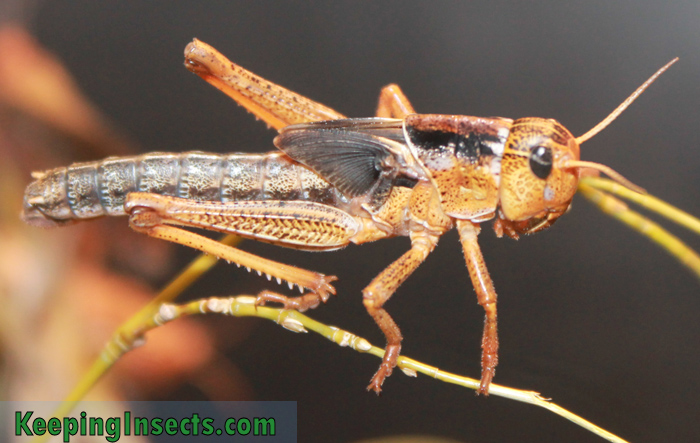
A grasshopper nymph. You can see it is not yet adult because of the short underdeveloped wings.
Grasshoppers fall in the order of Orthoptera, in the suborder Caelifera. Grasshoppers are sometimes called locusts. There are many species, the most famous ones are the desert grasshoppers that also occur in the bible as one of the plagues. Both species Locusta migratoria and Schistocerca gregaria are desert grasshoppers and are in the family Acrididae. Both species reach a size of around 7 cm in length.
Development and life cycle of grasshoppers
A female grasshopper lays eggs in small egg clusters, usually in the ground but she can also deposit them in plant material. Young grasshoppers are called nymphs and already look like miniature versions of the parents. Nymphs lack wings, only adult grasshoppers have fully functional wings. Grasshopper nymphs grow fast and shed their skin (molt) around 8 times in the process. At the last molt both males and females grow long wings that pass the abdomen.
It takes around 2 – 3 weeks for eggs to hatch. In around 4 weeks the nymphs reach adulthood. Around two weeks after that they begin to mate and produce eggs. If the temperature is low, development and breeding will slow down too. A grasshopper will die of old age when it has been an adult for around 5 months.
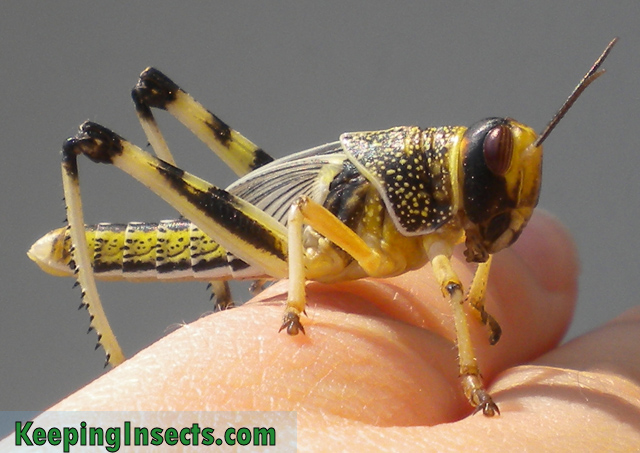
Schistocerca gregaria nymph
Housing your grasshoppers
Housing grasshoppers is easy. You need a container that is big enough, has some ventilation and can be closed properly to prevent escape. Grasshoppers can chew through fabric gauze, so net cages or cages with a fabric cover are not suitable for grasshoppers. A fauna box, a glass terrarium or a plastic terrarium with metal mesh for ventilation will do. If you keep the grasshoppers as pets, a glass terrarium with a mesh lid will look good. If you keep the grasshoppers to feed them to reptiles or praying mantises you a plastic container is more practical, as it is lightweight and cheaper. Make sure the container is big enough for all grasshoppers. Twelve adult grasshoppers need a cage of around 50 x 50 x 30 cm at least. Bigger is always better.
Fill the bottom of the container with dry sand, dry oatmeal flakes or dry coconut fibers. Place some dry twigs or branches in the enclosure to provide extra surface for the grasshoppers to sit on. The food of the grasshoppers, grass and/or leaves, will also serve as decoration and perching areas. Make sure light reaches into the container, either by a light bulb (see next section about Temperature) or by natural light. Direct sunlight shining into the enclosure could heat it up too much, make sure to prevent overheating.
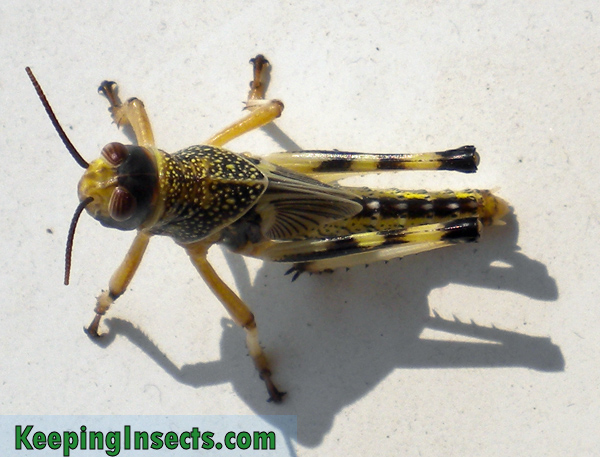
Schistocerca gregaria nymph seen from top
Temperature and humidity
The grasshopper species Locusta migratoria and Schistocerca gregaria are desert species. They need a dry and warm environment to thrive. A too humid environment will result in infections and death of the grasshoppers. A too cold environment will slow down development and make breeding grasshoppers impossible.
Keep the temperature during the day between 25 and 35 degrees Celsius. By night you can allow the temperature to drop to 15 degrees Celsius. The best way to heat the enclosure of grasshoppers is with a regular light bulb. It is also possible to heat the terrarium with a species heat bulb, found in reptile-specialized pet shops. You can heat the enclosure with a heat mat too. More information about heating any insect enclosure can be read at our page Temperature.
Keep the humidity low by placing dry bedding in the enclosure (dry coconut fiber, oatmeal flakes or dry sand) and not spraying with water. Grasshoppers do need moisture to survive, but can get this from their food. Lightly spray fresh food with water before feeding it to your grasshoppers. If you feel like the enclosure is getting moist, for example when you have an enclosure with little ventilation or if the enclosure is placed in a room with high air humidity, then you can better skip the spraying of the food. The locusts will get all their moisture from the fresh plant material that you give them.
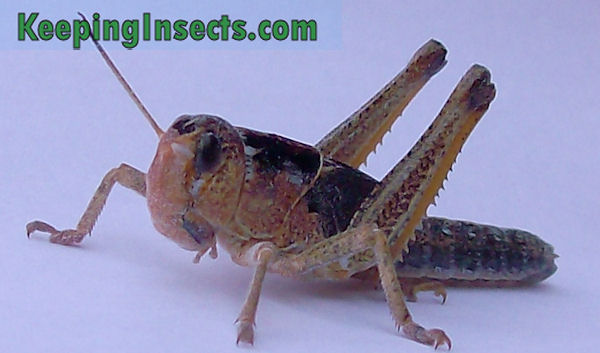
Locusta migratoria nymph
Food and feeding grasshoppers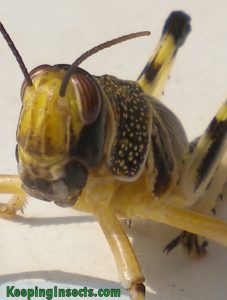
Locusta migratoria and Schistocerca gregaria eat only plant material. The best food and easiest food you can give them is fresh grass. Even better is fresh reed, reedgrass or canary grass (Phalaris arundinacea) if available. Fresh wheat leaves, corn leaves and other vegetable plants may also be eaten. But actually, many plant species will be eaten by grasshoppers. You can try to feed them any kind of grass-like species; if they eat the plants, it means that this is a suitable plant species. Generally grasshoppers will refuse to eat any poisonous plants. Be very aware of insecticide, if any plant has been spraying with insecticide it will be deadly to your grasshoppers.
Place the food plants inside the enclosure of the grasshoppers. They will start to eat from it instantly. At some point the plant will be too dry to eat, then the grasshoppers should be fed again with fresh plants. Once in a while you should clear out all old dry plant material from the enclosure.

Schistocerca gregaria nymph
Breeding grasshoppers
It is very easy to breed grasshoppers as long as you keep them in the right circumstances. They really need high temperature, low humidity and plenty of fresh food. If you have males and females, breeding will occur naturally. You don’t need to move the eggs or nymphs to a different container. If you like, you can of course. The nymphs are very small, so you might want to keep them in a different container than the parents to cater to their needs, prevent escaping and keep a better eye on them.
If you really keep grasshoppers well, you will be awarded with a lot of young grasshoppers. Make sure this is actually what you want! If you don’t want to breed with the grasshoppers, remove the bedding with the eggs or collect the eggs and place them in the freezer. This will kill the eggs before they start to develop. Never release grasshoppers into nature. They can cause plagues, disrupt nature and compete with native grasshopper species.
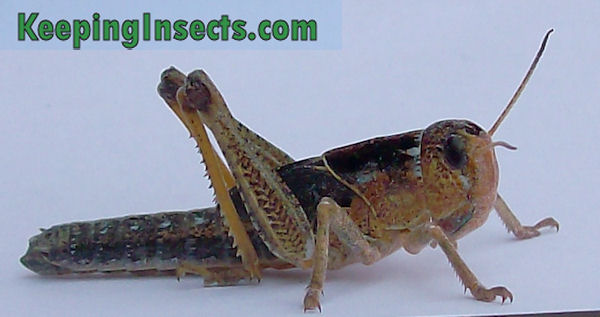
Locusta migratoria nymph
Buying grasshoppers
It’s actually very easy so buy grasshoppers. You can buy them in reptile-oriented pet shops. They are sold there as feeder animals. They are sold in different sizes, from small nymphs, to bigger nymphs and to adults. If you want to keep them for fun, you can better buy the nymphs. If you want to breed them, it’s faster to just buy the adults.
Make sure the grasshoppers look healthy when you buy them. There should not be any dead grasshoppers in the container.
